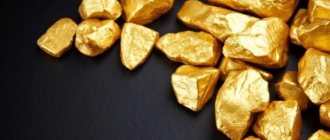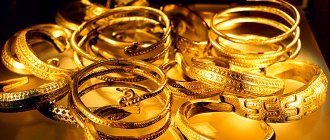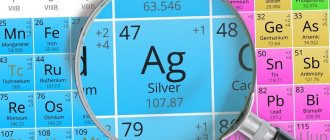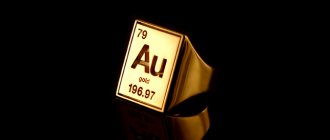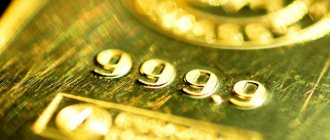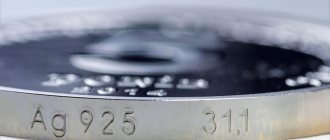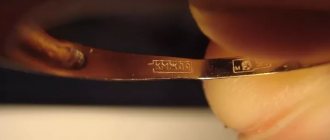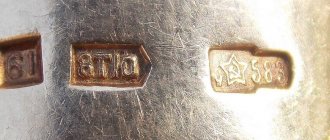Determining the purity of gold is important if the precious metal is purchased as an investment method. It is almost impossible to do this by eye, although there are some differences. This process will be especially difficult if the gold is colored - red, pink, white, green or other unusual shades. How to determine the gold standard in this case?
Before doing such a difficult task, you need to find out whether it is gold at all. Fortunately, this question is much easier to answer - there are quite simple and accessible methods. One of them is the determination of gold using a magnet. As you know, precious metals are not magnetic, and in most cases the absence of a jewelry reaction to a magnet means its authenticity. But some other non-ferrous metals and alloys, such as copper or brass, are also not magnetic, so this method will not give a 100% guarantee.
Differences between different gold samples by color
There are some other methods to find out:
- If you drop iodine on a piece of gold, it will leave a stain.
- A lapis pencil can be used to identify copper. After wetting it with water and applying a pencil, it will darken.
- If you roll the product in the crumb of black bread for several days and then break it, then traces of mold indicate that it is a fake.
- When rubbing the product on ceramic tiles, gold should not leave any traces.
- Gold dipped in vinegar should not change its color, and the vinegar should not become cloudy. Otherwise it's fake.
Characteristics of gold
Precious gold is a heavy metal. Its pure density is 19,621 kg/m³. To perceive a dry fact as clearly as possible, imagine a small ball of pure metal with a diameter of 46 mm. Its mass will be 1 kilogram.
The high density of gold is also used in its mining: it is thanks to it that nuggets and sand can be sifted out from rocks by washing.
The density of gold in its pure form (that which is considered to be 999.99 fineness) is 19.3 g/cm3. Native, it has a slightly lower density: 18-18.5 g/cm3. This indicator is different in alloys of different samples. We will talk about them further.
Ultrasonic authentication of gold in a coin
The so-called ultrasonographic method for identifying counterfeits is taken from medical practice. It makes it possible to see a cross section of the object being examined. If a gold coin or bar has irregular inclusions of foreign metals, this will be visible on the display. The method is based on the fact that sound travels differently through different metals. But such a check is unacceptable for Proof coins, as it can damage them. The CertiPack shell may also interfere with research.
Density of gold alloys
As we know from school courses, the density of a material is a physical property defined as the mass of a given unit of volume. It is measured through the ratio of body weight and its size.
To obtain alloys suitable for use in jewelry production, gold is mixed with copper, silver, nickel, platinum, palladium and other metals, both noble and not. Let's move on to data on the density of gold alloys of different grades.
The most popular, affordable and perfect for working with it is 585 standard. The density of 585 gold is 12.5-14 g/cm3. The same framework is determined by the 583rd sample (Soviet sample).
For coin samples, 900th and 917th, the figures are, respectively, 17.10-17.24 g/cm3 and 17.34-17.83 g/cm3.
Also commonly found in jewelry, the 750th sample has a density of 14.5-17.5 g/cm3.
The density of low-grade gold, 375 standard, is 11.54-11.56 g/cm3.
And finally, let's remember another noble metal - silver. It is significantly lighter than gold, and the density of silver alloys is also lower.
Thus, the density of the most common 925 alloy in products is 10.36 g/cm3. The second most used, 875th sample, is 10.28 g/cm3.
The density of gold and silver is an important indicator that helps determine the content of pure noble metal in an alloy using various methods. We will talk about one of them, accessible, further.
Use of magnetism
Gold also differs from other metals in its magnetic permeability. This precious metal is diamagnetic (it is repelled by a magnet) in contrast to tungsten, which is paramagnetic (it can be attracted by a magnet). Therefore, when a magnet is applied to pure gold items, they should slightly repel. To increase the accuracy of determining the authenticity of gold in coins using this method, you can use special magnetic scales. They will reliably show the repulsive or attractive magnetic properties of an object. Typically, such measuring instruments are accompanied by tabular values corresponding to certain gold coins and bars. This research method is quite applicable even to bullion gold in a special shell.
Hydrostatic method: determining a sample of a precious alloy
Institutions specializing in receiving gold products use many different methods to determine and confirm the sample of brought gold. Based on the knowledge that gold is a heavy metal with high density, the hydrostatic method was introduced.
It is based on determining the difference in weight when measuring parameters in the open air, under normal conditions, and in a liquid with a certainly known density.
Let’s make a reservation right away: this method of testing gold is only suitable for complete products, without stones or other inserts made from other materials. It is also impossible to obtain adequate data on hollow products consisting of many moving parts.
To carry out hydrostatic weighing of a gold item, you will need a jewelry scale, a measuring cup (or any other transparent one), fishing line or thin thread. Distilled water is usually used as a liquid of known density. First, the gold product is weighed using the usual method, and the data is recorded. Then a glass of water filled more than half is placed on the scales, the scale readings are reset to zero (the scales must have a function for resetting the tare weight). Our gold product, suspended on a fishing line, is completely lowered into the water, without touching the bottom and walls of the glass. The scale data is also recorded.
For density analysis, it is better to use a hydrostatic calculator, since manual calculations will take much longer and are not as accurate.
How to determine gold at home
So how can you identify real gold at home? There are several ways to determine the quality of gold and its authenticity using available means. We are sure that you have most of the items needed for testing in your medicine cabinet or kitchen. Therefore, if you have long wanted to check the authenticity of a gold ring or chain, let's start experimenting.
How to test gold with iodine
Let's start with instructions on how to test gold with iodine at home. This antiseptic is in the medicine cabinet of any home, so you don’t have to go far. So, what does an iodine test consist of?
Testing gold with iodine
Take a cotton swab, iodine and something sharp (knife, pin or needle). On the jewelry being tested - preferably from the inside - make a small scratch or lightly scrape off the top layer of metal. Apply a little iodine to a cotton swab and wipe the scratched area.
If the iodine turns white and begins to evaporate, this is a fake. The reaction of gold to iodine is completely different. When in contact with real gold, iodine remains dark and does not evaporate for a long time, and a dark spot will appear at the test site. After the experiment, wipe off the iodine as soon as possible so that the dark stain does not remain on the jewelry forever.
Testing gold with acid or special reagents
You can check the authenticity of gold jewelry using reagents at any pawnshop. Buyers use a touchstone (silica shale) to test and then apply acid. After contact with the stone, a small amount of metal remains on the gold, which reacts with one or another acid. Under the influence of acid, the fake coating will evaporate. A qualitative reaction to gold is when the trace of the stone remains in place.
Testing gold with vinegar
Another thing that is in every home is vinegar. It can also be used to test gold for authenticity.
Test gold for authenticity with vinegar
Pour the vinegar into a clear glass, then place the decoration in it and leave for a few minutes. Fake gold will darken very quickly in vinegar, while real gold will retain its shine and color.
Checking with a magnet
Gold is not magnetic
The main thing you need to remember is that gold is not magnetic. At all. Only gold-plated jewelry made of steel, iron, nickel and other heavy metals are magnetic. Therefore, if your ring or earring “sticks” too much to a kitchen magnet, you have a fake.
How to test gold with a lapis pencil
A lapis pencil, which is sold in any pharmacy and costs no more than 150 rubles, will also help you recognize gold. The lapis pencil is based on silver nitrate, which reacts with metals.
Testing gold with lapis pencil
To test, wet the jewelry, then draw a small line with a lapis pencil and wash it off. If there is a mark left from the pencil, the gold is either fake or of very low standard. There will be no harm to high-quality gold from such a test.
Watch video: How to test gold at home
conclusions
So, in our article we looked at the density of gold - a precious metal that each of us has encountered in life and will still encounter. The data presented can be summarized as follows: the density of the most popular gold standard, 585, is 12.5-14 g/cm3, for other alloys it is lower or higher, respectively.
Based on the density of the gold alloy, the sample can be determined, which is an indicator of the pure gold content in the alloy. These methods are used in institutions that accept gold.
We hope our article was informative and gave you a few exciting minutes. Let there be only real high-grade gold in your box!
How to determine gold purity
Gold products intended for the general market are always hallmarked. This is a three-digit imprint on the inside of the product. Samples are 375 (the lowest), 500, 583, 585, 750, 916, 958, 999 (the highest - only a gram of impurities per kilogram of metal). Use a magnifying glass to examine the markings on your jewelry.
Gold samples
Gold without purity can most often be found in pawn shops (where it is most often a fake or a product of very low quality). However, sometimes jewelry is made to order without testing. Such items are passed down from generation to generation in families and are highly valued.
It will be quite difficult to accurately determine the gold sample at home. To do this, you will need nitrogen chloride and assay needles, which can only be purchased in specialized stores. Apply nitrogen to the surface of the product and monitor the reaction. If nothing has changed within two seconds, you have 585 gold or higher. If after a few minutes the stain from the solution turns brown, then the metal is below 585 standard. And if the stain turns black, then it is completely fake.
In order not to accidentally spoil the item, it is better to first use one of the methods suggested above to make sure that your jewelry is made of real gold, and then go to a specialist.
Category: question-answer
I checked the ring to see if it was gold or not. How can I get rid of iodine stains now?
Expert opinion
Pribrezhny Gennady Valentinovich
Jeweler 6th category
Iodine blots can be easily cleaned with hydrogen peroxide and soap. Prepare a solution by mixing soap with peroxide and place the ring there for half an hour. After this, the ring will need to be rinsed with running water and wiped dry.
Will vinegar corrode gold when tested?
Expert opinion
Andrey Seleznev
Chemist-technologist, Volgograd
Solar metal is quite difficult to dissolve. This can only be done with the help of aggressive concentrated acids, nitric and hydrochloric, a mixture of which is also called aqua regia. Therefore, testing gold with vinegar will not give any reaction.
What does it mean if a gold ring is slightly attracted to a magnet?
Expert opinion
Grishanov Mikhail Petrovich
Jeweler, director of the Grishanov and Co. workshop
Most likely, the gold ring contains impurities, they can become magnetic. In such situations, it is worth assessing the force of gravity. If the ring is strongly magnetic, it makes sense to check it with a series of home tests.
High-quality gold transmits magnetic waves.
Gold ring on a magnet
Is it possible to test gold by tooth? How reliable is the method?
Expert opinion
Pribrezhny Gennady Valentinovich
Jeweler 6th category
The old verification method was relevant several centuries ago. The precious metal used for minting coins is very soft. Since the coins consisted mostly of it, people, fearing counterfeits, bit the money and examined the surface for signs of teeth.
Now it’s definitely not worth checking jewelry “by the tooth.” There are many other more reliable methods. In addition, it is very easy to make mistakes using only teeth.
Lead, for example, is even softer than the solar metal. If you bite it, marks will definitely remain.
I was given handmade gold earrings for my birthday, how can I check their authenticity and purity?
Expert opinion
Grishanov Mikhail Petrovich
Jeweler, director of the Grishanov and Co. workshop
It’s definitely worth turning to professionals in a jewelry workshop. Masters have all the necessary tools to obtain an accurate result. You can try to find out the sample yourself using a set of acids, but the resulting value will only be approximate. In addition, such a purchase is not practical for one-time use.
What is the purity of real white and yellow gold?
Everyone knows very well that a gold product must have a hallmark - a sign confirming its authenticity. Almost everyone knows what this test means. We explain to the uninformed - the number on the sample means the number of milligrams of pure gold contained in one gram of the alloy from which the product is made.
IMPORTANT: Pure gold, 999 purity, is not very suitable for creating jewelry. This gold is very soft and not resistant to external factors. Products made from it deform very quickly. Therefore, jewelers use alloys in which element 79 of the periodic table is diluted with some other, more durable metal, for example, silver, nickel, cobalt, palladium, zinc.
There are several gold assay systems. The most used and recognizable are carat and metric.
Samples of “real” gold.
IMPORTANT: Products and jewelry with a purity from 999 to 375 are considered gold. But it should be taken into account that the latter contains only 38% of pure aurum, they tend to fade in the sun, and their appearance is not quite the same.
Pure gold.
999 standard gold.
Interestingly, white gold jewelry comes in 750 and 585 samples. The product acquires its white color due to the presence of silver, nickel or palladium in the alloy, which color it, and rhodium plating.
Metals. included in the alloy of 18-carat white gold.
Is it possible to check gold at a pawnshop?
Pawn shops that buy gold employ experienced appraisers who know how to assess the authenticity and purity of precious metals. The prestige of the pawnshop depends on their professionalism, so you can completely trust them. If in doubt, ask an expert to do a test with a tool stone or spectrometer.
In pawnshops, gold is checked by experts - appraisers.
How to check the authenticity of white and yellow gold with a lapis pencil: photo
Lapis pencil is a pharmaceutical product containing an antiseptic used to stop minor bleeding from abrasions, scratches, cuts, etc. If you wet an item whose value is in doubt and then run this pencil over it, you can easily find out whether it is a fake or not. There should be no traces on the gold.
Lapis pencil is a pharmaceutical product used to test gold for authenticity.
How to avoid tungsten counterfeits?
Some of the most difficult counterfeit gold items to detect involve tungsten. Its density is almost identical, and this metal is relatively inexpensive. Here are some of the best ways to avoid problems:
1. Avoid large gold bars. 10 ounce and 50 gram gold bars are the easiest to counterfeit as they can have holes drilled into them, filled with tungsten and then resealed with gold. The situation is more complicated with smaller sizes, 1 ounce and less. Tungsten is harder than gold. This means that it is very difficult to use in coining or making small items due to its fragility.
2. Avoid deals that are too good to be true. As they say, the miser pays twice.
3. Buy silver. There is no metal that has a similar density, making it difficult to counterfeit.
How to check the authenticity of white and yellow gold with vinegar: photo
Don't be afraid to test your gold with vinegar. If it is real, nothing will happen to him, and a fake will sooner or later become unusable. So:
- pour vinegar into a small container
- lower the product being tested into it for 60-90 seconds
- the fake will darken, but the color of the gold product will remain unchanged
Testing gold with vinegar.
